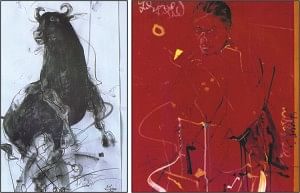"Symphony in Drawing": Ranjit's economic and dramatic strokes

Drawings by Ranjit
Ranjit Das' latest venture Symphony in drawing, which is on at Shilpangan, includes more than just drawings: It has acrylic and washes in watercolour, apart from Chinese colour and ink, and charcoal. Collage and mixed media have been used as well.
"Just drawing would make it monotonous," Ranjit comments. This is his first solo exhibition in Bangladesh in four years, as he was busy working on his exhibitions in India -- at the National Art Gallery in New Delhi; Jahangir Art Gallery in Mumbai and ICCR Gallery in Hyderabad. Ranjit feels that it is important for an artist to get exposure abroad, so that art enthusiasts worldwide are aware of the quality of Bangladeshi art.
Ranjit's subject, over the years, has been lyrical depictions of man and his environment. This time, along with careful portraits with quick strokes, he has brought in domestic animals -- like bulls, horses, dogs, goats and sheep, which he comes across during his frequent visits to his village. The beauty of the drawings is the economy of strokes and the powerful lines. Bauls with dhol and dotara, seemingly in trance, have been depicted. Other subjects include women, casually fixing their hair or tending to their young ones clinging to their breasts.
"Starting from 2002, all subjects in my paintings have their origin in the rural areas," says Ranjit. Men smoking hukkah, women plaiting their neighbour's hair, individuals in burqa and others sporting goggles, some crossing the ferry are typical of his subjects.
Inspired by the defiant bull done by Shilpacharya Zainul Abedin, Ranjit has sketched his bull though this is from a totally different angle. The fleeing horse is full of vigour and is presented repeatedly with impact. The dog and the goat are also remarkable.
One of the works has a vibrant golden background with flecked, silver dots for texture. The mother and child figures have been done with watercolour and they too have minimal strokes. The impact is dramatic and daring. A blind baul singer, who sometimes comes to Dhaka, has been immortalised in Ranjit's lines and colours. The lonely figure of a dismal woman, wrapped in thoughts of her own, has been presented effectively too.
The landscapes depict boats, launches, the riverbanks, along with bold sweeps bringing in the horizon and the river. These are done in deft charcoal lines.
Before going to school, as a child, Ranjit used to draw on walls and the floor with charcoal. Having done his BFA from Dhaka, he finished his masters from Baroda, studying under K.G. Subramanian. Ranjit says that Sunil Das and Monirul Islam have inspired him too. At the Institute of Fine Arts, he had Anwarul Haq, Abdul Baset and Rafiqun Nabi as his guides. M. Kibria and Safiuddin Ahmed have also been his mentors.
Ranjit has had 19 solo exhibitions in Kolkata, Hyderabad, Mumbai, New Delhi, Montreal and Karachi. He has taken part in 75 joint exhibitions in India, China, Japan, Korea, Malaysia, USA, Bulgaria, France, Kuwait and Qatar. He has ten awards to his credit, including the Grand Award in the 7th Asian Biennale (1995).
Symphony in drawing is on till May 28.

 For all latest news, follow The Daily Star's Google News channel.
For all latest news, follow The Daily Star's Google News channel. 


Comments